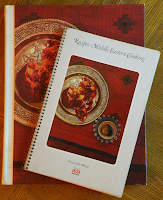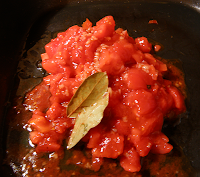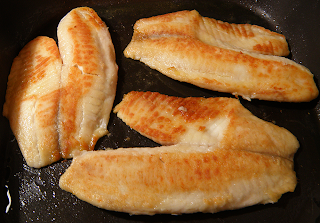 |
| Psari Savori, both Flavorful and Colorful |
Recipe adapted from Middle Eastern Cooking
Back in the 1970s, I discovered the first all-ethnic-cookbook I’d ever seen on my sister’s in-laws’ bookshelf. The Cooking of Scandinavia was one of a Time-Life book series called Foods of the World. Each book consisted of two volumes, a large picture book and a small spiral bound recipe book, featuring cuisine of various countries and ethnic groups. The beautiful (pre-Photoshop) photos and the descriptions of foods and customs of other nations inspired my young mind and opened up a whole new world of cooking and travel ideas for my future. You can still find these books at flea markets and used book vendors, and they are fun forays into the pre-globalized world of the late 1960s.
 |
| Interesting Reading |
The Middle Eastern Cooking picture book is particularly interesting because it was written at a time before largescale American intervention in this area. Each nation is presented with some naivete, without political comment. Chapters feature recipes and early 20th century cultural history of Greece, Turkey, the Arab States, Iraq, Israel, Iran, and Egypt—as seen by mid-century Americans. How-to photos include how to stuff and shape a grape leaf, bone a fish, and braid challah. This is a Greek recipe from the Middle Eastern Cooking spiral-bound recipe volume.
 |
| Coat Fish Lightly with Flour |
 |
| Sauce at Beginning of Cooking |
 |
| Electric Frying Pan Ensures Golden-cooked Fish |
serves 6
Six 6 oz. tilapia fillets, or other lean white fish
~ ½ tsp. salt
½ c. flour
3 – 4 tbsp. olive oil
~4 large or 12 small tomatoes
1 tsp. tomato paste
3 tbsp. red wine vinegar
½ tsp. minced garlic
1 large or 2 small bay leaves
½ tsp. salt
freshly ground black pepper
Skin tomatoes for sauce by dropping tomatoes into boiling water for 15 – 30 seconds, then plunging in cold water to loosen skins. If skin is too thick to split the first time, make 2 – 4 short cuts in the tomato skin with a knife and repeat the boiling and chilling steps. Peel tomatoes with sharp knife and remove stem end. Slice tomatoes in half crosswise and squeeze to remove seeds and liquid. Chop tomatoes into ½ inch chunks. Be sure that you have 1 ½ cups, or a little more.
Mix together tomato paste, wine vinegar, minced garlic, ½ tsp. salt and bay leaves, and add a few grinds of black pepper. This will be added to the tomatoes to make the sauce after fish is cooked.
Spread flour in a layer on a dinner plate. Pat fish fillets dry with towel. Sprinkle lightly on both sides with salt. Dredge both sides of fillets in flour and shake off excess. Heat an electric frying pan to 400 degrees. Add 1 ½ tbsp. oil and swish around to coat bottom of pan. Add 3 fish fillets. Lower heat to 375 degrees, and cook until fillets start to look opaque, about 6 minutes for tilapia. Check underneath a fillet to see that it’s golden brown, and flip it when it is. Cook until fish is completely opaque and fish will flake, about 5 minutes for tilapia. Remove three fillets to plate and blot off excess oil with paper towel. Raise heat to 400 degrees, add another 1 ½ tbsp. oil and swish it around, then repeat the cooking process for the other three fillets.
When all fish is cooked and plated, add tomatoes and premixed sauce ingredients to frying pan. Cook at 375 - 400 degrees, a lively boil. Stir constantly as mixture and cooks down, smashing down large pieces of tomato with back of stirring spoon—using a big wooden spoon helps. Cook down until mixture is thick enough to hold its shape almost solidly in the spoon, about 5 minutes.
Serve fish topped with sauce. Traditionally, psari savori is served at room temperature, but it’s great warm too. Its traditional accompaniments are crusty loaves of fresh bread and green salad.

No comments:
Post a Comment